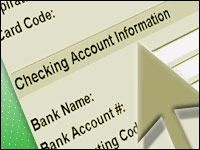
Millions of consumers have switched their bill-paying practices from tedious sessions with a stack of statements and checkbooks to streamlined, paperless payments through a variety of online channels. However, the movement to electronic payments still has a long way to go, based on recent reports, and a huge majority of consumers have not yet been weaned away from their checkbook chores and welcomed to the world of paperless payments.
As a result, billers, financial institutions, and the information technology vendors who provide online payment programs still have an opportunity to profit from the large potential market in electronic payments. In fact, there’s a bit of a tug of war going on between the major players.
On one side are the billers — such as merchants, utilities and credit card firms — that provide their own direct online bill pay services. On the other are financial institutions such as banks and credit unions, which offer bill payment as part of their online offerings.
In 2009, 44 million U.S. households used online payment mechanisms provided directly by billers to pay at least some of their bills, according to a study released in January by Online Banking Report. That channel will grow by 26 percent to 56 million households by 2012.
In 2009, about 26 million households used third-party online bill-pay services such as those offered by financial institutions and other consolidators, the study found. By 2012, the number of households using third-party channels will grow by 11 percent to 29 million.
Transactions in the Billions
The biller direct channel handled 3 billion transactions in 2006 and grew by 50 percent to 4.5 billion transactions in 2009, Aite Group estimates. Bill payment transactions handled by banks and other third parties grew by a third, from 1.4 billion transactions in 2006 to 2.0 billion in 2009.
Longer term, the forecast for electronic bill paying is even more impressive.
“The potential for using either direct billing or bill paying through online banking still hasn’t matured,” Mark Schwanhausser, senior analyst for multichannel financial services at Javelin Strategy and Research, told the E-Commerce Times.
A very high percentage of consumers still receive many bills in paper form and, as a result, keep paying bills by paper, noted Javelin in a January 2010 study on consumer attitudes toward online bill payments.
Three billing groups — mobile phone vendors, credit card issuers, and mortgage lenders — have enjoyed “remarkable savings” from persuading customers to convert to electronic statements, Javelin found.
However, at least 70 percent of consumers still receive paper statements for 14 common bills, “underscoring how much improvement and savings remain to be achieved,” the report notes.
To a large degree, most online bill payments are conducted by consumers who are relatively comfortable with electronic transactions. Still, many consumers in this category have yet to fully exploit the online payments alternative. A big hurdle for billers and financial institutions is to tap into this huge market of online literate consumers who, for one reason or another, underuse the channel.
Clutter, Green Themes
Both direct billers and financial institutions will have to be more proactive to bring consumers into the world of electronic payments. The primary marketing target should be consumers with at least some familiarization with online transactions, Javelin recommends in its report.
“Banks, credit unions, billers and vendors are wise to target segments of consumers who are most inclined to convert to electronic statements, including ‘moneyhawks’ who regularly receive electronic financial alerts, online banking customers, tech-savvy consumers, green-minded consumers, Gen Y and Gen X,” the report says.
Three major marketing themes are most likely to attract these consumers: reducing clutter, helping the environment and safeguarding finances.
Many consumers are seeking a central location to manage all of their finances, a factor that favors banks and credit unions offering online bill payment services as part of their electronic banking packages, Javelin’s research indicates.
While financial institutions may be well positioned to gain a major slice of online bill processing, some billers have been reluctant to share their electronic payment processing with banks or credit unions. One reason is that billers feel they may lose marketing opportunities to further engage customers if the bill payment process is conducted through a third party.
“The issue comes from the billers’ difficulty with the question of who owns the consumer,” Javelin’s Schwanhausser said.
“There has definitely been that kind of tension between billers and financial institutions, and it may always be present,” Beth Robertson, director of payments research at Javelin, told the E-Commerce Times. “But this is an evolutionary process, and I think billers and financial institutions both recognize that the primary goal is to get the customer into an online environment.”
The cost savings for online payments, estimated as high as US$1 per bill in paper, postage and processing, are too compelling for billers to ignore, whether the payment is made through a direct channel or through financial institutions.
“Most billers want satisfied customers, and they are increasingly aware that giving consumers a choice of payment channels should be part of their customer relations management plan,” Robertson said.
One difficulty for billers in cooperating with financial institutions is the issue of smoothly transferring consumer remittances, as well as proper information on the consumer accounts, from the banks to the billers.
“I think the industry has largely overcome those issues, and it’s not a major impediment anymore,” Jim Breune, editor of the Online Banking Report, told the E-Commerce Times.
On rare occasions, though, when a consumer has a problem with a bill handled through a bank or credit union, the resolution of the problem can be vexing, Breune noted.
Shift From Paper
Of the vendors currently serving the biller direct channel, only three — Fiserv, FIS and Online Resources — provide programs for both biller direct and consolidator (third party) applications, according to the Aite report. Firms that provide strictly biller direct processing services include Western Union, Kubra, MoneyGram, BNY Mellon, JP Morgan Chase, Tier Technologies and IPP.
Vendors targeting the biller direct channel will continue to see “strong organic growth opportunities from consumers and small businesses shifting from paper to electronic payments,” Aite said, noting that the vendor marketplace remains very fragmented, leaving room for further consolidation.
Vendors, however, need to target potential customers appropriately.
“There are really two distinct markets,” Gwenn Bezard, a senior analyst at Aite, told the E-Commerce Times. “For billers, you are dealing mainly with a back-office, bill collection operations function, whereas with banks, the online programs are related to a more strategic part of marketing their retail banking services.”
Vendors providing financial institutions with online bill payment products also have good prospects for future growth. The opportunities include providing programs to banks and credit unions that have yet to incorporate online bill services, as well as to financial institutions that need to continuously upgrade their existing platforms. Recently both Fiserv and Online Resources rolled out more customer-friendly versions of their online bill payments programs.
“There is still lots of growth left for vendors, and not just for the majors like Fiserv,” Online Banking Report’s Breune said. “There’s room for smaller providers to get some of that business too.”










































Social Media
See all Social Media